Top 5 Signs It’s Time to Replace Your AC Unit Before the Next Heatwave
With hot summer days ahead, making sure your air conditioner is ready to tackle the temperatures should be top of mind. If your AC is nearing the end of its lifespan or showing signs of failure, it may not make it through the next cooling season. Rising energy bills, frequent breakdowns, and ineffective cooling are some of the top signals that you may be left scorching during the next heatwave.
Knowing the signs you need a new cooling system helps you get ahead of the busy season and schedule AC replacement before it’s too late.

Why Waiting Until the Heatwave Is Risky
As the hot summer months come near, having a properly working air conditioner is key to keeping your home cool and comfortable. While many homeowners may consider pushing off their AC upgrade until next season, that’s a risky choice that could leave you without cooling when you need it most.
During a heatwave, HVAC companies become overrun with repair and replacement requests. If your unit breaks down during a hot spell, you may be left waiting for days or paying premium prices for the replacement cost. Knowing when to replace your AC before the summer rush offers peace of mind that your unit will be running and ready to tackle the scorching days ahead.
1. Your Energy Bills Keep Climbing
If your energy bills are rising but you’re not using your air conditioner any more than usual, it’s likely time for an upgrade. A failing or aging unit requires more power to cool your home, causing your energy usage and monthly expenses to rise. Upgrading to a new, energy-efficient air conditioner helps keep your bills down as your unit works overtime during the heatwave ahead.
2. Your AC Unit Is Over 10–15 Years Old
With proper maintenance, you can expect your air conditioner to last between 10 and 15 years. If yours is nearing the end of its lifespan, it’s best to upgrade before a heatwave arrives so you’re not left without cooling when you need it most. An aging air conditioner will struggle to cool your home as temperatures rise and may even break down when they reach their peak.
3. Your System Runs Constantly but Cools Poorly
If you have an old AC that’s not cooling your home to a comfortable temperature, it’s likely time for a replacement. Over time, air conditioners lose their efficiency and struggle to cool effectively, especially when temperatures reach their peak. To make sure your unit is ready to handle an upcoming heatwave, consider making the switch to a new system that can keep up with demand.
4. You’re Facing Frequent or Costly Repairs
While you’ll likely have to deal with an AC repair throughout your unit’s lifespan, it shouldn’t be breaking down regularly. If you’re constantly calling for cooling service, it may be time to consider purchasing a new system. Upgrading to a new unit helps you save on recurring repair bills and offers peace of mind that you can rely on your AC when a heatwave arrives.
5. Your Indoor Air Quality Is Declining
As air circulates through your cooling system, it removes dust, debris, and other irritants that diminish indoor air quality. If you’re noticing an increase in allergy symptoms or see visible dust near your vents, your filter may be struggling to filter these contaminants. Replacing your air conditioner helps improve circulation and filtration, creating a cleaner and healthier indoor environment.
The Benefits of Upgrading Your AC Before Peak Season
If your air conditioner is showing signs that it’s due for an upgrade, there’s no time to waste. Getting ahead of the summer rush helps keep your household safe, comfortable, and cool when the next heat wave arrives. Some of the top advantages of upgrading before peak season include:
- Lower service prices: Upgrading early helps avoid the service surcharge many HVAC companies charge during the summer to account for increased demand.
- Reliable comfort: With a new AC system in place, you won’t have to worry about whether your unit can handle the hot temperatures ahead.
- Energy savings: Newer models operate more efficiently than older units, keeping your energy bills and usage low even on the hottest of days.
- Potential savings: Many HVAC companies offer promotions, discounts, or special offers during the off-season that can help you save on your AC upgrade.
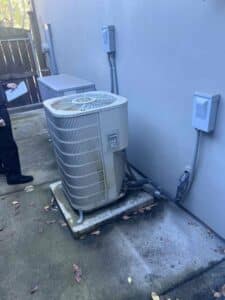
Choosing the Right AC Unit for Your Home
Air conditioners come in varying designs, sizes, and efficiency levels. When searching for a new system, it’s important to find a model that suits your home's size, layout, and cooling needs. A unit that’s too small has to run constantly, wearing out faster and struggling to keep up with your cooling needs. On the other hand, one that’s too large may short cycle, leading to uneven temperatures, excess wear, and higher energy bills.
Before deciding on a cooling system, consider the following factors:
- Your home size and layout
- The unit’s SEER rating
- Your budget
- The condition of your ductwork
- Zoning requirements
- The local climate
Is It Time for a Professional AC Assessment?
If you’re having trouble determining which air conditioner is right for your home, contact a reputable HVAC company near you to schedule an inspection. They’ll perform a thorough inspection of your home, including its size and layout, the condition of the ductwork, and the quality of the insulation.
Once the evaluation is complete, they’ll discuss your budget, efficiency preferences, and cooling needs to recommend the right system for your space. Working with a reputable AC technician helps you find the best option for your home and avoids costly mistakes or improper installations.
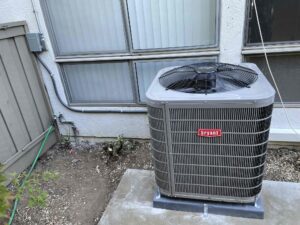
Stay Ahead of the Heat with a Reliable AC System from TRIO!
Don’t wait until it’s too late. Schedule an air conditioner replacement with TRIO Heating, Air & Plumbing today! Our trusted HVAC proudly serves San Jose and surrounding areas with top-notch AC solutions that keep your home cool and comfortable when you need it most. Whether you need a new AC installation, quick repair, or routine maintenance, you can count on our team to get the job done right. Call us or book online to speak with a team member today!
How Whole House Purification Systems Can Improve Your Family's Health
Here at TRIO Heating, Air & Plumbing , we understand how indoor air quality can directly impact your family’s health and comfort. While many homeowners focus on temperature control, the quality of air circulating through your home deserves equal attention. A whole-house purification system offers comprehensive protection against airborne pollutants that can affect respiratory health. Investing in an HVAC air filtration system means investing in the wellness and comfort of your family.

Why Indoor Air Quality Shouldn’t Be Ignored
Did you know that indoor air can be two to five times more polluted than outdoor air? The American Lung Association reports that indoor air can be up to 100 times worse. Most families spend upwards of 90% of their time indoors, breathing air that may contain dust, pet dander, pollen, mold spores, bacteria, viruses, and volatile organic compounds (VOCs).
Poor indoor air quality has been linked to a variety of troubling health concerns like eye irritation, persistent headaches, and chronic fatigue. Long-term exposure to polluted indoor air may contribute to more serious conditions, including asthma, allergies, and other respiratory illnesses.
Many San Francisco Bay Area homes, particularly older properties or those in high-traffic areas, experience unique air quality challenges due to environmental factors, wildfire smoke, and urban pollution. Appropriate air quality services can help mitigate these risks, including the installation of a whole-home air cleaner.
What Is a Whole House Purification System?
One of the best ways to improve air quality in your home is with a whole-house purification system. The integrated air cleaning solution works with your existing HVAC system to filter and purify all the air circulating throughout your home. Unlike standalone units that only clean air in a single room, HVAC air filtration systems provide comprehensive coverage for every living space.
Modern whole-house purification systems typically include multiple filtration stages:
- High-efficiency particulate air (HEPA) or high-MERV rated filters
- UV light purification technology
- Activated carbon components for odor control
- Photocatalytic oxidation technology
At TRIO Heating, Air & Plumbing , we offer advanced whole-house purification systems designed to address the specific indoor air quality concerns of Bay Area residents, from seasonal allergies to wildfire smoke infiltration.
How These Systems Work with Your HVAC
Whole-house air purifiers integrate directly with your existing heating and cooling system, providing continuous air purification wherever your system operates.
The central air purifier is typically installed at the return air duct or attached to your air handler. As air circulates through your home’s existing ductwork, it passes through multiple levels of filtration before being redistributed. The purification process effectively removes microscopic particles, neutralizes bacteria and viruses, and eliminates odors and chemical vapors.
The air scrubber installation process requires professional expertise to maximize efficiency. Our skilled technicians position units strategically within your ductwork system, mounting them securely and ensuring all connections are properly sealed to prevent air leaks that could reduce effectiveness.

Top Health Benefits for Your Family
The benefits of air purifiers are significant. Investing in a whole-home air cleaner delivers several health advantages for everyone in your household.
- Reduced allergies: By removing allergens, an allergy relief air purifier in your home can decrease symptoms like sneezing, itchy eyes, and congestion.
- Asthma management: Cleaner air means fewer triggers for asthma sufferers, possibly helping to reduce the frequency and severity of asthma attacks.
- Elimination of harmful microorganisms: Advanced air purification systems for your home can neutralize bacteria, viruses, and mold spores, helping to prevent the spread of illness between family members.
- Removal of harmful chemicals: Many household products release VOCs that can cause headaches, dizziness, and respiratory challenges. Whole-house purification systems with activated carbon can effectively remove these harmful compounds.
- Better sleep quality: Cleaner air promotes better breathing during sleep, which can improve overall sleep quality and energy levels.
- Protecting vulnerable family members: Children, elderly adults, and anyone with existing health conditions benefit the most from improved indoor air quality.
Whole House vs. Portable Purifiers
There are significant differences between portable units and whole-house purification systems. Most notably, whole-home air cleaners purify all the air flowing through your home’s ventilation system. By contrast, portable units only purify air in a single room, rarely covering more than 300 to 700 feet.
Portable air purifiers need frequent filter changes and cleaning, whereas whole-house systems require maintenance only once or twice per year. A single integrated system is more energy-efficient than running multiple portable units, and also operates quietly within your ductwork, hidden away from sight.
For comprehensive protection throughout your San Francisco Bay Area home, an HVAC air filtration system offers superior performance and convenience.
Choosing the Right System for Your Home
Our skilled technicians work closely with you to select the appropriate air purification system for your home. In offering recommendations, they’ll evaluate several key factors:
- Home size and layout
- Existing HVAC configuration and ductwork
- Specific indoor air quality concerns, like allergies, asthma, and odors
- Budget considerations
- Long-term maintenance plans
To recommend the most effective solutions for your specific needs, our team conducts thorough assessments and considers the unique characteristics of your home. We empower you to make an informed decision based on your budget.
Maintenance Tips for Optimal Air Purification
To maximize the long-term effectiveness and efficiency of your whole-house purification system, follow these helpful tips:
- Replace filters regularly according to manufacturer recommendations
- Schedule regular preventative maintenance and inspections
- Keep vents and returns clear of obstructions
- Maintain humidity levels between 30% and 50%
- Reduce indoor pollutants by continuing basic housekeeping practices
- Consider seasonal maintenance before peak allergy seasons
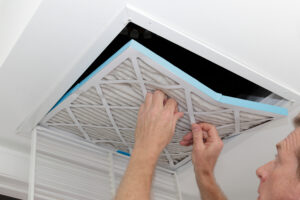
Is It Time to Upgrade Your Air Filtration?
It may be time to upgrade your indoor air quality solution if you notice the following:
- Frequent respiratory symptoms at home
- Excess dust accumulation throughout your home
- Newly developed allergies or asthma
- Persistent odors despite regular cleaning
You should also consider upgrading if you’re concerned about airborne viruses and illness, or you’ve come to rely on multiple portable air purifiers for different rooms.
An integrated approach to improve air quality in your home provides more comprehensive protection than piecemeal solutions.
Final Thoughts: Breathing Cleaner, Healthier Air
A whole-house purification system represents a sound investment in your family’s long-term health and comfort. By addressing indoor air quality comprehensively, these systems protect against a wide range of pollutants that can affect respiratory health and overall wellness.
At TRIO Heating, Air & Plumbing , we’re committed to helping families in Northern California breathe easier with professional indoor air quality services tailored to your specific needs. Contact us today at (415) 233-9302 to schedule your whole-house air purification consultation.
What To Include in Your Annual AC Maintenance Checklist
Summer temperatures in the Greater San Francisco Bay Area have been heating up in recent years, which means you need a reliable air conditioning system to keep you cool. Using a thorough annual AC maintenance checklist is one way to protect your investment and ensure reliable comfort.
The experts at TRIO Heating, Air & Plumbing provide reliable AC maintenance services to customers in the Bay Area. Explore some tips to help you keep an AC maintenance checklist that you can use every season.

Why Annual AC Maintenance Matters
Routine AC maintenance is important for many reasons. Here’s why sticking to a regular HVAC maintenance schedule matters.
Improves Energy Efficiency
A well-maintained AC system runs smoothly with good airflow, which helps it operate more efficiently. Not only is this great for your air conditioner, but it’s also better for the environment. Plus, when your AC runs efficiently, it helps you save money on your monthly energy bills.
Better Indoor Air Quality
Clean air filters and components don’t just help to preserve your AC system. This simple maintenance task also improves the air quality in your home by preventing airborne particles and contaminants from getting into the air. When your AC is free of dust and debris, the indoor air is much cleaner, keeping you and your family healthy.
Prevents Costly Repairs
Annual maintenance is one of the most effective ways to prevent AC breakdowns. A thorough inspection performed by the experienced team at TRIO can pinpoint minor problems early and get them repaired. The sooner you identify and correct less urgent issues, the less chance they’ll turn into costly repairs or a full system breakdown.
What Happens if You Skip AC Maintenance?
You might be tempted to skip AC maintenance to save time and money, but it can lead to a variety of issues. Some risks of skipping your AC maintenance routine include:
- System runs less efficiently: A poorly maintained AC system won’t run as efficiently as it should, which may lead to higher energy bills during the summer.
- Potential breakdowns: Without annual AC maintenance service, your system runs the risk of breaking down, forcing you to schedule an emergency repair.
- Shorter lifespan: Regular maintenance extends the service life of your system, and without it, you run the risk of having to pay for a full system replacement.
- Voided warranty: Many air conditioner brands require you to schedule regular maintenance to keep the warranty active and valid.

Complete AC Maintenance Checklist for Homeowners
Following an air conditioner maintenance checklist is a smart way to make sure your system gets the routine care it needs. Consider these helpful AC tune-up tips to get the most out of your air conditioner:
- Check and replace filters: Replace your AC filter every 30 to 90 days. Checking the filter for debris and dirt regularly and changing it as needed is the best way to support good airflow and energy efficiency.
- Clean the indoor unit: Clean your indoor unit, including the evaporator coil, with a soft, clean cloth to prevent excess buildup.
- Monitor the thermostat: Make sure your thermostat’s temperature matches the temperature inside your home. If it doesn’t, you may need an inspection or repair.
- Clean the condenser unit: Clean your outdoor condenser unit and remove debris from the surrounding area to protect it from damage.
- Inspect the insulation: Insulation around the AC’s copper piping maintains thermal efficiency. If it’s damaged or missing and needs to be replaced, contact TRIO right away.
- Schedule routine maintenance: The best way to protect your air conditioner is to schedule maintenance performed by professionals at least once a year.
How AC Tune-Ups Improve Performance and Efficiency
One of the biggest benefits of AC maintenance, including tune-ups, is improved performance and efficiency. Tune-ups help your system perform as efficiently as possible in the following ways.
Keeps Important Components Clean
A routine tune-up includes cleaning major components like the evaporator coil. Keeping these parts clean preserves lifespan and supports better airflow for a more efficient system.
Monitors Refrigerant Levels
Refrigerant leaks and low refrigerant levels are a common cause of AC malfunction. A routine inspection and tune-up lets you know if your air conditioner is leaking refrigerant. If levels are low, a technician will refill the refrigerant to keep the system running smoothly.
Ensures Maximum Efficiency
The best way to achieve AC efficiency improvement is with routine professional maintenance. From lubricating components and cleaning or changing the air filter to monitoring refrigerant levels, an annual AC tune-up gives your system the care it needs to run as reliably as possible when temperatures climb.
The Benefits of Professional AC Maintenance Services
Scheduling professional AC maintenance services comes with a range of benefits that make getting these services well worth the cost:
- Peace of mind: Professional AC maintenance gives you peace of mind knowing you’re protecting your investment and helps you receive reliable cooling all summer long.
- Addresses issues early: Maintenance performed by an experienced HVAC technician is the best way to identify and address minor issues early before they turn into expensive and stressful repairs.
- Keeps indoor air clean: Professional maintenance keeps the air inside your home clean thanks to regular filter changes and cleaning of important components that could lead to dirty indoor air if clogged or blocked.
- Helps maintain property resale value: When your AC is well-maintained, it protects not just the value of your system, but also the value of your home as a whole.
When To Consider Replacing Your AC Unit
While routine maintenance is key to keeping your AC running smoothly, there are times when you’ll need a replacement. Look for these signs indicating the need for AC maintenance or replacement:
- System age: Air conditioners that are 10 to 15 years old or older may be near the end of their lifespan, and a replacement could be a better option.
- Frequent repairs: If you’re paying for frequent repairs, it might be more cost-effective to upgrade to a new AC unit.
- High energy bills: When your summer energy bills suddenly skyrocket, there’s a good chance it’s related to a failing or malfunctioning AC system.
- Loud noises: Unusual noises or vibrations coming from your AC unit are a sign that something is wrong, and a full replacement may be recommended.

Contact TRIO for Your Annual AC Maintenance
If you live in the San Francisco Bay Area, annual maintenance is the best way to protect your system and keep you cool. The experts at TRIO Heating, Air & Plumbing proudly provide professional maintenance services for optimum performance. Contact us today to schedule your annual AC maintenance service!
What Is a Whole-House Purification System and How Does It Work?
Every homeowner wants clean, healthy air, but not everyone realizes that the air inside their home can be more polluted than the air outside. Between dust, pet dander, volatile organic compounds (VOCs), mold spores, and allergens, indoor air quality can take a serious hit without proper filtration. That’s where a whole-house purification system installation comes in. Read on to learn more from the experts at TRIO Heating, Air & Plumbing .

What Is a Whole-House Purification System?
A whole-house purification system is an advanced filtration unit installed directly into your home’s HVAC (heating, ventilation, and air conditioning) system. Unlike portable air purifiers that only clean the air in a single room, a whole-house system works throughout your home, promoting indoor air quality improvement on every floor.
These systems are designed to remove a wide variety of airborne contaminants, including:
- Dust and dirt
- Pollen and other allergens
- Mold spores
- Pet dander
- Smoke
- VOCs (volatile organic compounds)
- Bacteria and viruses
The result? Cleaner, fresher air is flowing through every room in your home. Many systems can even tackle microscopic particles that conventional HVAC filters often miss. This filtration level is essential for comfort and long-term health, especially for children, seniors, or anyone with compromised immunity.
A whole-house purification system is one of the best investments you can make for your home and health. It works quietly behind the scenes, improving the air you breathe, reducing allergens, eliminating odors, and protecting your HVAC system, all while contributing to a cleaner, healthier living space.
Benefits of a Whole-House Purification System
The most apparent benefit of whole-home air purification is cleaner air. These benefits can be life-changing for families with allergies, asthma, or other respiratory conditions. A quality system can trap up to 99% of airborne particles and help eliminate harmful pathogens. Below are a few more benefits of air filtration systems.
Healthier Living Environment
Less dust, mold, and bacteria mean healthier living, sleeping, and working spaces. You’ll notice fewer allergy symptoms, reduced respiratory irritation, and even fewer colds or infections over time.
Odor Elimination
Many systems include activated carbon filters, which help eliminate unpleasant odors from cooking, pets, smoke, or chemicals. Your home smells as clean as it feels.
Lower Cleaning Frequency
Cleaner air leads to less dust buildup on furniture and floors. That means less time spent cleaning and a more comfortable living environment overall.
Protection for your HVAC System
Purification systems help extend the life of equipment and improve its efficiency by trapping airborne particles before they reach HVAC components. A cleaner system works better and lasts longer.
Lower Energy Usage
Cleaner HVAC components also mean lower energy consumption. When air can move freely through your ducts and filters aren’t clogged with debris, your system doesn't have to work as hard, helping you save on monthly utility bills.

Components of a Whole House Purification System
While systems can vary based on brand and model, most whole-house purification system components include the following:
- Pre-filters: These catch larger particles like dust, hair, and debris, helping to protect and prolong the life of the finer filters that follow.
- HEPA filters: HEPA (High-Efficiency Particulate Air) filters can trap 99.97% of particles as small as 0.3 microns. They are critical for removing allergens, smoke, and bacteria from the air.
- Activated carbon filters: These absorb gases, chemicals, and odors. They’re especially helpful for households with pets, smokers, or people who engage in strong-smelling activities like cooking or painting.
- UV light purifiers: Ultraviolet light kills bacteria, viruses, and mold spores. These are often installed in the HVAC system’s air handler to disinfect the air as it passes through.
- Electrostatic filters: Some systems use electrostatic attraction to trap airborne particles. Depending on the model, these filters can be washable and reusable.
Installation Process
Installing a whole-house purification system is not a DIY project. It involves working directly with your HVAC system and should be handled by a certified technician. Here’s what you can generally expect:
- Step one: A technician evaluates your current HVAC setup, home size, and specific air quality concerns to help determine which purification system is the right fit.
- Step two: A specific model and configuration are chosen depending on your needs (allergy relief, odor control, pathogen elimination) and budget.
- Step three: The system is integrated into your HVAC unit, typically at the air handler or furnace. The technician will also ensure that all seals are tight and the system functions properly.
- Step four: The system will be tested post-installation for effectiveness and efficiency in terms of airflow and air quality.
- Step five: You’ll be shown how the system works, what to look out for, and how to monitor filter life or schedule maintenance.
Maintenance Requirements
Like any system in your home, a whole-house purification system requires regular maintenance to function correctly and extend its lifespan. Check for things like:
- Filter replacement: Most filters — especially HEPA and carbon filters — need to be replaced every 6 to 12 months, depending on usage and air quality.
- UV lamp replacement: If your system includes a UV light, the bulb typically needs to be replaced every 12 months to maintain its germ-killing effectiveness.
- System checkups: It’s a good idea to schedule annual HVAC inspections that include checking your air purification components. This ensures optimal airflow, cleanliness, and functionality.
- Cleaning: Some electrostatic filters or washable pre-filters should be cleaned regularly, typically every 1 to 3 months. Regular maintenance keeps your air clean, helps prevent system breakdowns, and keeps your energy bills in check.
Neglecting regular maintenance can reduce your system’s effectiveness and even lead to air quality issues. A clogged filter, for instance, not only restricts airflow but can also allow pollutants to bypass filtration entirely.

Call TRIO Heating, Air & Plumbing
The air quality experts at TRIO Heating, Air & Plumbing are here to help you take the next step toward cleaner indoor air. Our certified professionals will assess your home’s unique needs and install the right purification system for you efficiently, affordably, and with care.
Don’t wait to experience the benefits of better air. Contact TRIO Heating, Air & Plumbing to schedule your free in-home consultation. Clean air is just a call away!
The Benefits of Professional AC Installation: Why DIY Isn't Worth It
After a fantastic day at Golden Gate Park in San Francisco, CA, the last thing you want to deal with is a non-working air conditioner. Unfortunately, this issue is quite common with homeowners who choose to do a DIY AC installation instead of turning to experienced professionals. Even if you have some HVAC experience, it’s best to hire an expert like the pros at TRIO Heating, Air & Plumbing to make sure that your new air conditioner is installed right the first time. From safety to maximum efficiency, we’ll explain why you should opt for a professional installation and why doing an AC installation DIY isn’t worth it in the long run.

The Pitfalls of DIY AC Installation
There are plenty of pitfalls when it comes to trying an AC installation on your own. Here are some of the cons of choosing DIY over a professional AC installation.
Safety Risks
Attempting to install an air conditioner yourself could result in serious problems, like experiencing an electrical shock or even causing a dangerous fire. Improper handling of refrigerant can pose a health risk, cause a leak, or might even create serious environmental damage. Most AC components are heavy, so moving or lifting them yourself may result in injury, while the sharp edges of various parts and ductwork can cause cuts.
Lower Efficiency and Performance
Improper sizing of your AC unit leads to lowered efficiency, uneven indoor temperatures, and could cause premature system failure. If you place the vents or ductwork incorrectly, it might lead to airflow problems, uneven cooling, and reduced system efficiency. Improper drainage leads to water damage and mold growth, while poorly installed or improperly sealed ductwork leads to air leaks and higher energy consumption. All of these factors cost you much more money in the long run.
Other Pitfalls
Aside from some serious safety risks and a reduction in efficiency, DIY AC installation can make your manufacturer’s warranty null and void, and you could be violating certain local building codes that could come back to haunt you later. Improper installation can also lead to damage to certain components that cost quite a lot of money to fix later down the line.

Advantages of Professional AC Installation
Now that you know more about the downsides and potential pitfalls of DIY, here are some important benefits of AC installation when the job is performed by experienced professionals.
Safety and Protection
Professionals know how to deal with things like refrigerant and electrical connections correctly to keep on top of AC system safety while minimizing damage. Plus, most manufacturers require that your new air conditioner be installed by a professional if you want to keep the warranty coverage valid. Not only that, but you’ll enjoy an extended system lifespan since the experts make sure that everything is installed correctly and up to code the first time.
Enhanced Performance
The expert technicians at TRIO Heating, Air & Plumbing always make sure that your new AC is sized correctly. This leads to effective, even, and efficient cooling to maximize comfort while reducing your overall energy consumption. When the system is installed properly, it reduces energy waste and leads to lower monthly utility costs.
More Benefits
Along with safety and performance, other benefits of professional installation include:
- Improved indoor air quality.
- Reduced risk of premature breakdowns.
- Time savings — focus on things you love and leave the installation up to us!
How Professional Installation Improves Efficiency
One of the most important professional AC installation benefits is that it improves system efficiency:
- Professionals make sure all ductwork and vents are installed and sealed properly to prevent air loss, improve airflow, and maintain system performance.
- HVAC experts know how to determine the correct size and type of air conditioner for your home based on its size and other factors to maximize efficiency.
- Skilled technicians verify that the refrigerant in your new AC is the correct type, proper level, and fully charged to keep cooling levels optimal while reducing energy consumption.
- The experts always make sure that your air conditioner’s components are installed and connected correctly to prevent expensive breakdowns and maximize energy efficiency.
- An experienced technician will give you advice about which size and type of AC system is best for your home and cooling needs while also making sure that the new AC is not too large or too small.
- A professional installation keeps your warranty valid, saving you money in the event of an unexpected breakdown.
Support and Guarantees from Professionals
TRIO Heating, Air & Plumbing is a trusted provider for all your home cooling needs. Here’s more information about the support and guarantees you’ll receive from trained professionals.
- Professionals like TRIO offer high-quality, reputable home cooling products made by some of the best brands in the industry today to give you peace of mind.
- When your AC is installed professionally, you’re guaranteed that everything is done right, and if not, TRIO will fix it.
- Experienced technicians follow a set of important standards and guidelines during every installation, including local building codes, so your AC is installed safely and correctly.
- Hiring professionals means that your old unit will be removed and disposed of safely, saving you time and hassle.
- The professionals at TRIO carefully install high-quality parts and equipment using the best cutting-edge technology and leading techniques.
- When the AC installation is complete, professionals thoroughly test the system to make sure it’s performing correctly, efficiently, and up to standard.
- The pros know how to install your new air conditioner without cutting corners.
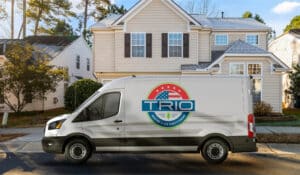
Contact TRIO Today!
If you live in the San Francisco Bay Area, CA, count on the experts at TRIO Heating, Air & Plumbing for the best professional AC installation experience. We’re dedicated to delivering outstanding service that always puts your satisfaction first. If you’re ready to schedule your professional AC installation and ensure your system is set up for peak performance and safety, contact us today!
Signs Your Air Ducts Need Cleaning: What to Look For
Spotting signs that you need air duct cleaning can be the difference between a healthy and comfortable home and unknowingly breathing in dust, allergens, and mold. If your vents are blowing more than just air, your HVAC system may not be working as it should. Here’s how to recognize the hidden warning signs before they turn into bigger problems.
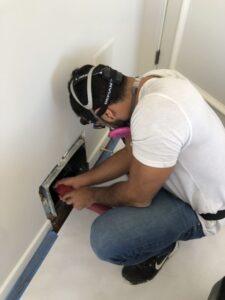
Why Clean Air Ducts Are Essential for Home Comfort
The condition of your air ducts impacts air quality, HVAC performance, and other aspects of your home’s comfort. When they become clogged with dust and debris and circulate these pollutants through your home and HVAC system, your indoor comfort suffers. Regular cleaning helps maintain a healthy ductwork system.
Improves Indoor Air Quality
Air ducts circulate air throughout a home, and particles from debris buildup inside air ducts can become airborne. As they spread across your living areas and worsen indoor air quality, household members may experience increased allergy symptoms and other discomfort. Common airborne contaminants include:
- Dust and dust mites
- Pet dander
- Pollen
- Mold spores
- Bacteria and viruses
- Volatile organic compounds (VOCs)
Clean air ducts help reduce these irritants, contributing to fresher and healthier air.
Enhances HVAC Efficiency and Performance
Dust and debris buildup in ducts restricts airflow, forcing your HVAC system to work harder to cool or heat your home. It can also spread throughout your system, coating important components and preventing them from operating as they should. A dirty evaporator coil, for example, limits the heat exchange process between the air and refrigerant, limiting AC performance and increasing the likelihood of frozen coils, leaks, and other problems.
Duct cleaning prevents obstructions from limiting airflow and disrupting the ductwork balance. With air moving as it should and with minimal contaminants, your HVAC system should experience enhanced efficiency, performance, and longevity.
Prevents Mold Growth and Odors
Air ducts are prone to humid environments that are ideal for mold growth. When moisture and organic matter accumulate, mold spores eventually germinate and grow. Mold spores contaminate the air and travel throughout your home, contributing to respiratory and cold-like symptoms and unpleasant musty odors from vents. Regular inspections and cleaning suppress and remove mold to maintain a fresh and spore-free indoor space.
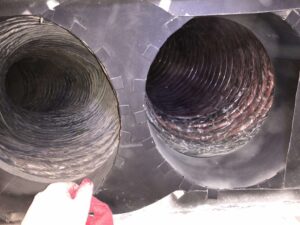
Common Signs Your Air Ducts Need Cleaning
Recognizing these signs helps alert you to dirty ducts before they escalate into more severe problems.
Excessive Dust Buildup in Vents and Registers
A noticeable layer of dust around supply and return vents suggests excessive dirt and debris circulating in your ductwork. When ducts become clogged, other surfaces in your home may also have greater dust buildup. If dust accumulates quickly despite regular cleaning, your ducts may be the problem.
Unexplained Allergy or Respiratory Issues
Airborne contaminants may cause allergy or respiratory symptoms to worsen indoors. If your symptoms improve when you’re away from home, you may be exposed to pollutants from your ductwork.
Mold or Mildew Smells
A persistent musty odor in your home may indicate mold in air ducts, especially if the smell is concentrated near the vents and intensifies during an AC or heating cycle. In some cases, mold may appear around the event openings, inside ducts, or on the evaporator coil.
Inconsistent Airflow
If your HVAC system struggles to cool or heat your home evenly, clogged air ducts may be restricting airflow. Hot or cold spots are most likely to occur near vents or in the areas furthest from vents.
Frequent HVAC Filter Clogs
HVAC filters typically require replacement every 30 to 90 days, depending on your home’s indoor conditions, but more frequent replacements than usual may suggest excessive debris traveling from the ductwork.
Increased Energy Bills
An inexplicable increase in energy bills may indicate HVAC efficiency problems stemming from ductwork problems.
What Happens If You Ignore Dirty Air Ducts?
Neglecting air duct maintenance may have long-term consequences for your household’s health and home comfort.
Poor Indoor Air Quality and Health Issues
People with asthma, allergies, or other respiratory conditions may be especially sensitive to contaminants circulated by dirty air ducts. Poor indoor air quality may exacerbate symptoms of preexisting conditions or cause other household members to experience sneezing, itchy eyes, difficulty breathing, and other respiratory discomfort. Long-term exposure to poor indoor air quality may have severe health consequences, particularly for children, seniors, and those with pre-existing conditions.
HVAC System Wear and Breakdowns
Dirty components, restricted airflow, and other inefficiencies associated with poor ductwork conditions accelerate wear on your HVAC system. As components strain and wear more quickly to match heating or cooling demands, your HVAC system is subject to an increasing risk of overheating, damage, and failure. Left unaddressed, excessive HVAC strain may result in costly repairs and even premature system replacement.
Fire Hazards
Although ducts may not cause a fire, accumulated dust, lint, and debris can be highly flammable. If ducts are near electrical wiring or heat sources, excessive dirt may increase fire risk.
Mold Growth and Structural Damage
If ducts develop extensive mold, it can spread throughout your home and damage walls, ceilings, and flooring. Mold may rot and weaken building structures, sometimes requiring remediation and structural repairs.
How Often Should You Get Your Air Ducts Cleaned?
Ducts require cleaning every three to five years, but the frequency of air duct cleaning depends on various household and environmental factors. These include:
- Homes with pets
- Household members with allergies or asthma
- Recent home renovations
- Humidity levels
- Excessive smoking or cooking indoors
- Regional air quality
If any of these conditions, your home and indoor air quality may benefit from more frequent duct cleaning services. An HVAC technician can also inspect and assess your ductwork during routine maintenance visits to determine whether your air ducts require cleaning.
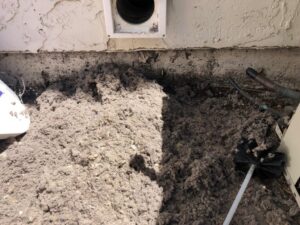
Schedule Professional Air Duct Cleaning With TRIO Heating, Air & Plumbing
TRIO Heating, Air & Plumbing provides thorough air duct cleaning to remove dust, allergens, and contaminants, protecting your home and optimizing HVAC system performance. Contact us and schedule professional duct cleaning with TRIO Heating, Air & Plumbing to improve air quality and HVAC efficiency.